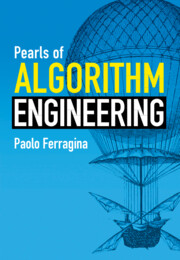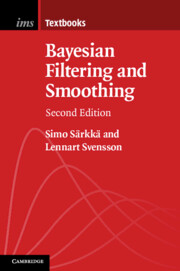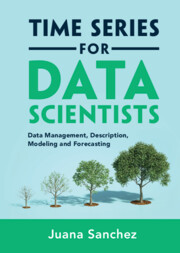Refine search
Actions for selected content:
6829 results in Communications and signal processing
Frontmatter
-
- Book:
- Bayesian Filtering and Smoothing
- Published online:
- 01 June 2023
- Print publication:
- 15 June 2023, pp i-iv
-
- Chapter
- Export citation
3 - Batch and Recursive Bayesian Estimation
-
- Book:
- Bayesian Filtering and Smoothing
- Published online:
- 01 June 2023
- Print publication:
- 15 June 2023, pp 27-43
-
- Chapter
- Export citation
List of Examples
-
- Book:
- Bayesian Filtering and Smoothing
- Published online:
- 01 June 2023
- Print publication:
- 15 June 2023, pp 393-396
-
- Chapter
- Export citation
16 - Parameter Estimation
-
- Book:
- Bayesian Filtering and Smoothing
- Published online:
- 01 June 2023
- Print publication:
- 15 June 2023, pp 319-348
-
- Chapter
- Export citation
8 - General Gaussian Filtering
-
- Book:
- Bayesian Filtering and Smoothing
- Published online:
- 01 June 2023
- Print publication:
- 15 June 2023, pp 131-167
-
- Chapter
- Export citation
5 - Modeling with State Space Models
-
- Book:
- Bayesian Filtering and Smoothing
- Published online:
- 01 June 2023
- Print publication:
- 15 June 2023, pp 73-90
-
- Chapter
- Export citation
4 - Discretization of Continuous-Time Dynamic Models
-
- Book:
- Bayesian Filtering and Smoothing
- Published online:
- 01 June 2023
- Print publication:
- 15 June 2023, pp 44-72
-
- Chapter
- Export citation
15 - Particle Smoothing
-
- Book:
- Bayesian Filtering and Smoothing
- Published online:
- 01 June 2023
- Print publication:
- 15 June 2023, pp 308-318
-
- Chapter
- Export citation
9 - Gaussian Filtering by Enabling Approximations
-
- Book:
- Bayesian Filtering and Smoothing
- Published online:
- 01 June 2023
- Print publication:
- 15 June 2023, pp 168-203
-
- Chapter
- Export citation
Preface
-
- Book:
- Bayesian Filtering and Smoothing
- Published online:
- 01 June 2023
- Print publication:
- 15 June 2023, pp xi-xiv
-
- Chapter
- Export citation
11 - Particle Filtering
-
- Book:
- Bayesian Filtering and Smoothing
- Published online:
- 01 June 2023
- Print publication:
- 15 June 2023, pp 229-252
-
- Chapter
- Export citation

Pearls of Algorithm Engineering
-
- Published online:
- 08 June 2023
- Print publication:
- 22 June 2023

Bayesian Filtering and Smoothing
-
- Published online:
- 01 June 2023
- Print publication:
- 15 June 2023

Time Series for Data Scientists
- Data Management, Description, Modeling and Forecasting
-
- Published online:
- 01 June 2023
- Print publication:
- 11 May 2023
-
- Textbook
- Export citation
Index
-
- Book:
- Time Series for Data Scientists
- Published online:
- 01 June 2023
- Print publication:
- 11 May 2023, pp 458-464
-
- Chapter
- Export citation
6 - ARIMA(p, d, q)(P, D, Q)F Modeling and Forecasting
- from Part II - Univariate Models of Temporal Dependence
-
- Book:
- Time Series for Data Scientists
- Published online:
- 01 June 2023
- Print publication:
- 11 May 2023, pp 245-312
-
- Chapter
- Export citation
Preface
-
- Book:
- Time Series for Data Scientists
- Published online:
- 01 June 2023
- Print publication:
- 11 May 2023, pp xi-xii
-
- Chapter
- Export citation
5 - Stationary Stochastic Processes
- from Part II - Univariate Models of Temporal Dependence
-
- Book:
- Time Series for Data Scientists
- Published online:
- 01 June 2023
- Print publication:
- 11 May 2023, pp 189-244
-
- Chapter
- Export citation
References
-
- Book:
- Time Series for Data Scientists
- Published online:
- 01 June 2023
- Print publication:
- 11 May 2023, pp 448-457
-
- Chapter
- Export citation
1 - Introduction to Time Series Data
- from Part I - Descriptive Features of Time Series Data
-
- Book:
- Time Series for Data Scientists
- Published online:
- 01 June 2023
- Print publication:
- 11 May 2023, pp 4-57
-
- Chapter
- Export citation
